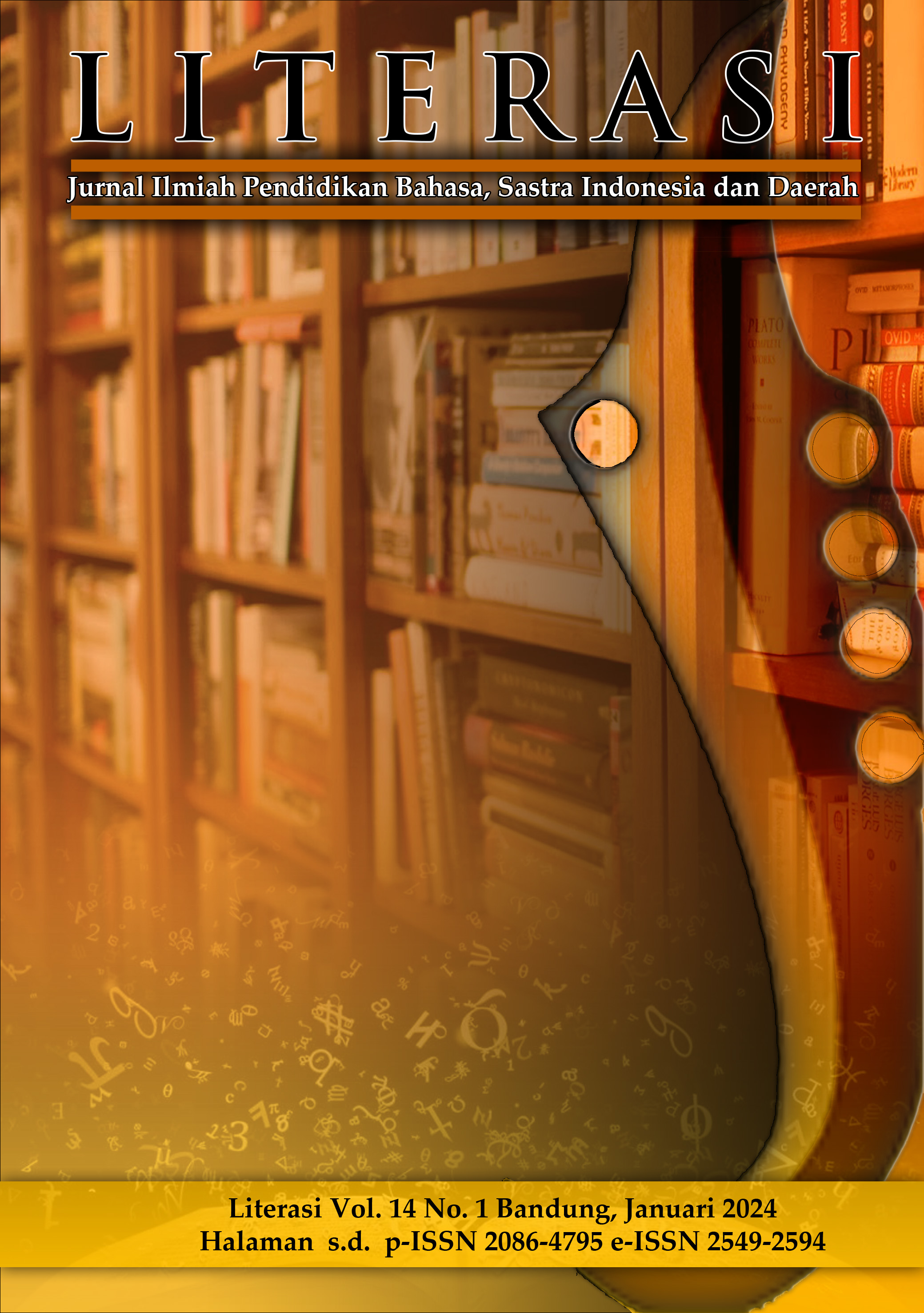EUFEMISME PENERJEMAHAN UNGKAPAN SEKSUAL NOVEL “SEPERTI DENDAM, RINDU HARUS DIBAYAR TUNTAS” KE DALAM BAHASA INGGRIS
DOI:
https://doi.org/10.23969/literasi.v14i1.10795Abstract
Euphemisms are often used in literary works The study aims to analyze the euphemistic form of sexuality expression in the translation of Eka Kurniawan's novel "Like Dendam, Rindu Must Be Paid Completely" into English and the factors of the euphemism. This research uses qualitative methods with a descriptive approach. The theory used is the euphemism theory of Allan and Burridge. The results of this study found 40 data on sexuality expressions divided into three categories, namely sexuality expressions that refer to physiological, sexual activity, and social life. The expression of sexuality that refers to a view of social life is the main finding in this study. In the three categories of sexuality expressions, 5 categories of euphemisms were found, namely part for whole, general for specific, remodeling, filipancy, and Omission. Cultural differences and the absence of matching words are the main factors in the euphemism in the translation of the novel.
Downloads
References
Abdelaal, N. M., & Al Sarhani, A. (2021). Subtitling strategies of swear words and taboo expressions in the movie “Training Day.” Heliyon, 7(7), e07351. https://doi.org/10.1016/j.heliyon.2021.e07351.
Al-Badawi, M. (2022). Translatability problems of Euphemistic Expressions in Najuib Mahfouz’s Palace of Desire: A Pragmatic-Stylistic Perspective. Academic Journal of Interdisciplinary Studies, 11(1), 341. https://doi.org/10.36941/ajis-2022-0030
Allan, K., & Burridge, K. (1991). Euphemism and Dysphemism: Language Used as Shield and Weapon. Oxford University Press.
Azis & Juanda. (2023). Student mental health euphemisms. XLinguae, 16(1), 51–59. https://doi.org/10.18355/XL.2023.16.01.04.
Azura, F., Dewi, H. D., & Hidayat, R. S. (2019). Profanity and Characterization: A Study of Translation Strategies and Their Effects on The Catcher in the Rye. Journal of Language and Literature, 19(2), 12.
Battistella, E. L. (2005). Bad Language: Are Some Words Better than Others? Oxford University Press.
Chen, X. (2022). Taboo Language in Non-Professional Subtitling on Bilibili.com: A Corpus-Based Study. Languages, 7(2), 138. https://doi.org/10.3390/languages7020138.
CNN Indonesia, T. (2018, Desember). Eka Kurniawan Raih Prince Claus Awards 2018 di Belanda. CNN Indonesia. https://www.cnnindonesia.com/hiburan/20181207140716-241-351876/eka-kurniawan-raih-prince-claus-awards-2018-di-belanda
Haleem, M. A. S. A. (2011). Euphemism in the Qur’an: A Case Study of Marital Relations as Depicted in Q. 2:222–3. Journal of Qur’anic Studies, 13(1), 125–131. https://doi.org/10.3366/jqs.2011.0010
Heryana, N. (2019). Eufemisme dan Disfemisme pada Media Berita Daring Republika: Perkembangan Kasus Setya Novanto Edisi Januari 2018. Jurnal Visi Ilmu Pendidikan, 11(1), 72. https://doi.org/10.26418/jvip.v11i1.30955.
Irianti, I., & Herlina, N. (2012). Buku Ajar Psikologi Untuk Mahasiswa Kebidanan (E. Mardella). Penerbit Buku Kedokteran EGC.
Khisamova, V., & Abdullina, L. (2022). The Problem of Euphemisms in the Medical Terminology of the English and Tatar Languages. Journal of Educational and Social Research, 12(1), 14. https://doi.org/10.36941/jesr-2022-0003
Kreidler, C. W. (1998). Introducing English semantics. Routledge.
Kwirinus, D. (2022). Menyingkap Teori Seksualitas Psikoanalisa Sigmund Freud dan Usaha Penerapannya dalam Pendidikan Seksualitas. Jurnal Pendidikan Sosiologi dan Humaniora, 13(2), 556. https://doi.org/10.26418/j-psh.v13i2.57871.
Mangum, D. T. (2020). Euphemism in Biblical Hebrew and the euphemistic ‘bless’ in the Septuagint of Job. HTS Teologiese Studies / Theological Studies, 76(4). https://doi.org/10.4102/hts.v76i4.6140.
Nababan, M. R., Santosa, R., & Hari, A. (2020). Shift on Functions of Sexual Euphemisms in English-Indonesian Translation of Duke of Her Own by Eloisa James. International Journal of Innovation, 13(4), 16.
Palu, M. (2022). Translating Sexual Taboos. The Bible Translator, 73(2), 240–251. https://doi.org/10.1177/20516770221104477
Terry, A. (2020). Euphemistic dysphemisms and dysphemistic euphemisms as means to convey irony and banter. Language and Literature: International Journal of Stylistics, 29(1), 57–75. https://doi.org/10.1177/0963947020910624
Universidad de Fudan (China), & Cai, Y. (2021). La explicitación en traducción o cómo traducir al español los eufemismos de tres obras clásicas chinas. Onomázein Revista de lingüística filología y traducción, 52, 81–98. https://doi.org/10.7764/onomazein.52.07.
Valdeón, R. A. (2020). Swearing and the vulgarization hypothesis in Spanish audiovisual translation. Journal of Pragmatics, 155, 261–272. https://doi.org/10.1016/j.pragma.2019.09.005
Wulansari, A., Arvianti, G. F., & Nila, S. F. (2019). Konsep Pemaknaan Sastra dalam Penerjemahan Karya Sastra.
Downloads
Published
Issue
Section
License
Copyright (c) 2024 Literasi: Jurnal Ilmiah Pendidikan Bahasa, Sastra Indonesia dan Daerah

This work is licensed under a Creative Commons Attribution 4.0 International License.
Hak cipta artikel yang diterbitkan di jurnal ilmiah dimiliki oleh penerbit, bukan penulis. Hal ini berkaitan dengan koordinasi hak akses untuk cetak ulang atau penggunaan lainnya. Dalam hal ini penerbit mempunyai keluluasaan untuk mempublikasikan artikel sesuai dengan kesepakanan Transfer Agreement (penyerahan hak cipta) antara penerbit dengan penulis.















